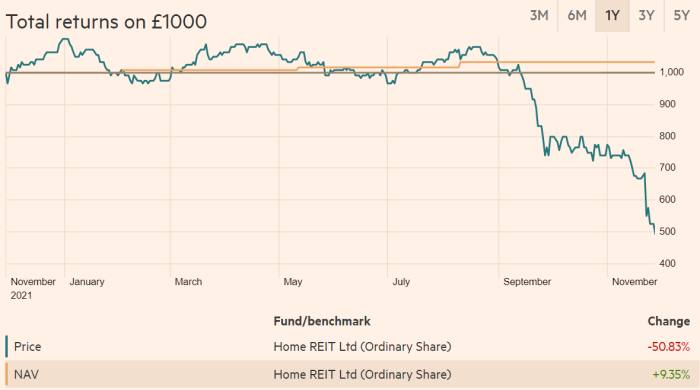
Never get between a gun and its target, says Lee Van Cleef in the 1967 Spaghetti Western Day of Anger. His advice summarises why FT Alphaville had so far been avoiding any mention of Home Reit, a UK-listed provider of sheltered housing, and its battle with activist short sellers. But the noise of gunfire is becoming increasingly difficult to ignore.
On Wednesday, Home Reit delivered a very lengthy rebuttal of a short-seller note published a week ago by Viceroy Research. Viceroy has already responded in typically aggressive fashion while repeating many of its original claims.
The headline allegations are that Home Reit’s client base of homelessness charities is of low quality with lots of overlaps; that straight-line accounting means revenue is booked upfront on leases that are long term and back loaded; and that relationships with its independent valuer and asset buyer look off.
Much of the argument stems from applying a conventional property management model to charities and community interest companies, where longevity and robust accounting practices can’t be assumed.
Home Reit argues that its rent roll is backstopped by the state and is inflation linked, meaning it can offer multi-decade leases with rent-free periods and financing of fit-out costs. Long-term leases also create a portfolio that can be valued by yield rather than by market price. Critics counter that the model amounts to a bait-and-switch on investors and have been putting pressure on chair Lynne Fennah to explain.
After reassuring that its rent roll to August 2022 had been paid in full, Home Reit’s rebuttal profiles each of its tenants individually to explain why its confidence in them is justified. Clients sharing offices, services and personnel isn’t a red flag within an small and underfunded sector, it says. Neither is an increase in rent receivables highlighted by Viceroy, because it’s a growing business and new tenants aren’t invoiced for up to three months.
Yet Home Reit’s nearly 13,000 word response has a few holes. Most pressingly, there’s not much clarity around with key tenant Circle Housing, which went into administration earlier this year.
To Viceroy, Circle’s entry into administration shows that Home Reit’s client base is fragile, and state support is illusory. Home Reit says the opposite, because in November the leases were transferred to another operator, One CIC, on the same rental terms.
One missing piece relates to social housing group Mears, which has sublet the Circle portfolio for ten years. Home Reit says the transfer required a kickback from an unidentified property developer to Circle “to cover the difference over the course of the lease between the cost of the head lease to Home Reit and the cost of the sublease to Mears.” The unanswered question is why, as Peel Hunt analysts highlight:
Whilst these leases (and the donation) have since been transferred to One CIC, it is not clear why the difference in rent exists, whether this impacts the valuation of those assets, and what happens at the end of the Mears sublease. Noble Tree, another tenant, also sublets to Mears, and it is unclear if similar issues exist here.
Peel Hunt’s team is not convinced by Home Reit’s rebuttal around apparent conflicts of interest, particularly where charity directors are involved in property development, and questions the company’s choice of rent affordability measures. (“We note that the price per bed per week that Home Reit charges for refurbished homes appears to be circa 35 per cent higher than those charged by PRS Reit for new-build properties.”)
Then there’s the question of who pays. During a property’s ramp-up stage the developer will “typically provide the company’s tenants with additional funding, usually representing twelve months of rent,” Home Reit explains.
This explanation matches a slide deck from September 2022 on Home Reit’s website, saying that “as part of each transaction, we ensure that the developer capitalises the Charity with a minimum of one year rent cover and sinking fund contribution.”
Where vendor financing becomes rent round-tripping is a matter of perspective. Back to Peel Hunt:
If this cost [of the sinking fund] is reflected in the purchase price paid by Home, is there a risk that shareholders have effectively been overpaying for properties, such that capital can be deployed quickly, and would this have been as necessary had Home grown at a more measured pace?
Another claim in Viceroy’s report is that properties are quickly flipped between tenants at a big profit. Home Reit warns against a straight comparison of sales prices, going into granular detail about hidden costs involved. Nevertheless, the underlying vendor profit margins in its cited examples — 18 per cent, 42 per cent, 37 per cent, 33 per cent, 20 per cent and 27 per cent — are hardly slim.
“Given the developments are largely de-risked (they are pre-let and pre-sold) and the developer requires minimal capital (Home Reit provides it), these still seem generous profit margins to us,” says Peel Hunt.
The appearance of an activist short seller in any investment case always prompts drama. In Home Reit’s case it has prompted the delay of results so its auditor can give the books an extra-hard frisk.
However it all resolves for Home Reit, the broader questions around financialisation of housing schemes for the homeless — in particular, whether a middleman landlord backstopped by the state would need to exist at all — are more likely to find an answer by Parliamentary inquiry than by a gunfight between the longs and shorts.
As Peel Hunt says:
At a fundamental level there is a mismatch between the lease lengths between Home and the tenants, and the income that the tenant is receiving to fund those rents. Additionally, there remains the concern that many of the tenants are small entities, with potential conflicts of interest, and high profit margins potentially being made for the developers . . .
Whilst the investment opportunity is characterised by long-dated leases (20-30 years), with inflation-linked rents (typically capped at 4 per cent and collared at 1 per cent or containing fixed uplifts), and rent payments funded indirectly by local or central government, we see reason for investors to continue to be concerned over the risk profile of such strategies, and are not surprised to see the share price exhibit continued weakness.
